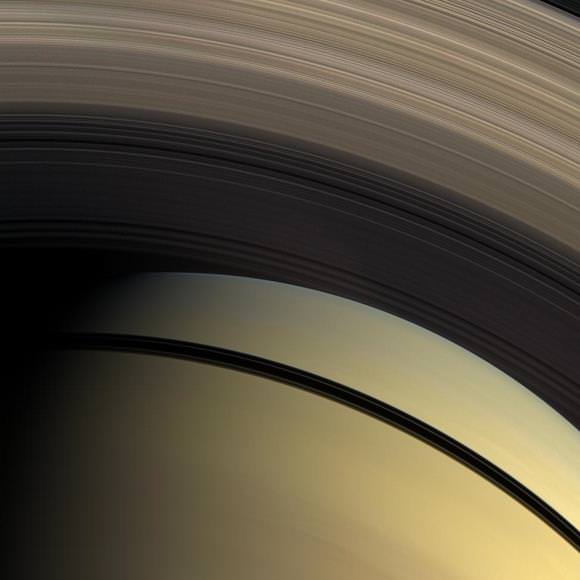[/caption] The latest images from the Cassini spacecraft include this gorgeous natural color view of Saturn's inner rings. Visible are the different degrees of transparency of the rings, which appear almost pastel in color. The dark shadows of the rings separate Saturn's southern hemisphere in the bottom of the image from the north. The innermost D ring is invisible, laid over the planet's northern hemisphere. The translucent C ring runs through the middle of the image. The denser B ring stretches across the top of the image. See below for more info on this image, as well as a challenge to "find the moons" on another Cassini image.
The view in the top image looks toward the sunlit side of the rings from about 48 degrees below the ringplane. Images taken using red, green and blue spectral filters were combined to create this natural color view. The images were acquired with the Cassini spacecraft wide-angle camera on Feb. 28, 2009 at a distance of approximately 1 million kilometers (620,000 miles) from Saturn. Image scale is 59 kilometers (37 miles) per pixel. [caption id="attachment_30052" align="aligncenter" width="580" caption="Three of Saturn's moons bunch together in this image by Cassini. Credit: NASA/JPL/Space Science Institute. Click for larger image."]
[/caption]
Can you find the three moons in this image? Janus (179 kilometers, or 111 miles across) sits bright and overexposed outside the faint F ring. Prometheus (86 kilometers, 53 miles across) lies inside the F ring to the left of the center of the image.
Have you given up on finding the third moon? Well, don't feel bad -- Tiny Daphnis (8 kilometers, or 5 miles across) is in there somewhere, but it's not visible in the thin Keeler Gap of the A ring just below Prometheus in this image.
This view looks toward the sunlit side of the rings from about 20 degrees below the ringplane. The image was taken in visible light with the Cassini spacecraft wide-angle camera on March 2, 2009. The view was acquired at a distance of approximately 1.1 million kilometers (684,000 miles) from Janus and at a Sun-Janus-spacecraft, or phase, angle of 47 degrees. Image scale is 63 kilometers (39 miles) per pixel.
Source:
Cassini Equinox Mission homepage
 Universe Today
Universe Today
